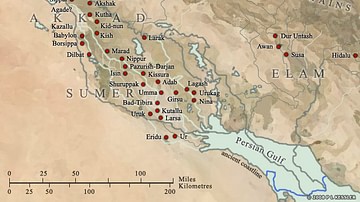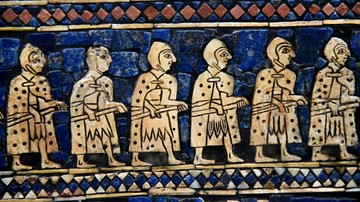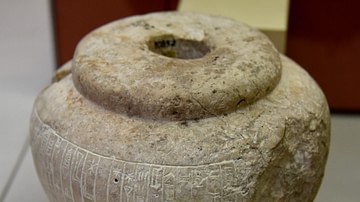Search
Remove Ads
Advertisement
Summary 
Loading AI-generated summary based on World History Encyclopedia articles ...
Search Results

Definition
Sumer
Sumer was the southernmost region of ancient Mesopotamia (modern-day Iraq and Kuwait) which is generally considered the cradle of civilization. The name comes from Akkadian, the language of the north of Mesopotamia, and means “land of the...

Image
Map of Sumer
The area which formed Sumer started at the Persian Gulf and reached north to the 'neck' of Mesopotamia where the two rivers, the Tigris and the Euphrates meander much closer to each other. To the east loomed the Zagros Mountains, where scattered...

Image
Bull Inlay from Sumer
An alabaster inlay of a bull. Early dynastic period, 2750-2300 BCE. From Sumer, southern Mesopotamia, Iraq. (The Burrell Collection, Glasgow, Scotland).

Image
Map of Sumer and Elam
Map with the locations of the main cities of Sumer and Elam.

Video
A Short History of Sumer and the Sumerian Civilization from Mesopotamia
The Sumerians flourished in Mesopotamia between c. 4100 – 1750 BCE in the region of Sumer which was not a country, but a region made up of a number of walled city-states, each with its own king. The Sumerian civilization developed the first...

Video
Ancient Mesopotamian Warfare in Sumer and Akkad
Warfare was an essential part of the Akkadian Empire, especially under its conquering founder Sargon, and his grandson the god-king Naram-Sin. Their armies were the source of their power. But they were not the first kings of Mesopotamia...

Definition
Sumerians
The Sumerians were the people of southern Mesopotamia whose civilization flourished between c. 4100-1750 BCE. Their name comes from the region which is frequently – and incorrectly – referred to as a “country”. Sumer was never a cohesive...

Definition
Ur-Nammu
Ur-Nammu (r. 2047-2030 BCE) was the founder of the Third Dynasty of Ur in Sumer who initiated the so-called Ur III Period (2047-1750 BCE) also known as the Sumerian Renaissance. He is best known as the king who composed the oldest extant...

Article
Sumerian Civilization: Inventing the Future
Imagine something that has never been thought of before. If one holds a book in one's hands, one can imagine an e-book, a large-print book, a picture book, all kinds of books. But how does one imagine a book in a world where even the concept...

Definition
Gutians
The Gutians were a West Asiatic people who are thought to have lived around the Zagros Mountains in a region referred to as Gutium. They had no written language and all that is known of them comes from their enemies, including the Akkadians...